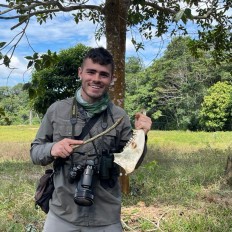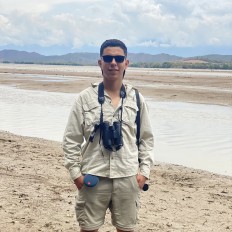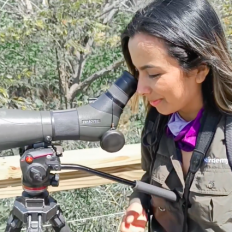Top species
- Torrent Duck (Merganetta armata)
- Wattled Guan (Aburria aburri)
- Lyre-tailed Nightjar (Uropsalis lyra)
- Green-fronted Lancebill (Doryfera ludovicae)
- Wire-crested Thorntail (Discosura popelairii)
- White-booted Racket-tail (Ocreatus underwoodii)
- Green-backed Hillstar (Urochroa leucura)
- Rufous-vented Whitetip (Urosticte ruficrissa)
- Violet-headed Hummingbird (Klais guimeti)
- Black-streaked Puffbird (Malacoptila fulvogularis)
- Crimson-rumped Toucanet (Aulacorhynchus haematopygus)
- Yellow-throated Toucan (Ramphastos ambiguus)
- Bronze-winged Parrot (Pionus chalcopterus)
- Maroon-tailed Parakeet (Pyrrhura melanura)
- Lined Antshrike (Thamnophilus tenuepunctatus)
- Foothill Stipplethroat (Epinecrophylla spodionota)
- Yellow-breasted Antwren (Herpsilochmus axillaris)
- East Andean Antbird (Drymophila caudata)
- Western Fire-eye (Pyriglena maura)
- Plain-backed Antpitta (Grallaria haplonota)
- Black-billed Treehunter (Thripadectes melanorhynchus)
- Pale-breasted Spinetail (Synallaxis albescens)
- Andean Cock-of-the-rock (Rupicola peruvianus)
- Barred Becard (Pachyramphus versicolor)
- Slaty-capped Flycatcher (Leptopogon superciliaris)
- Scale-crested Pygmy-Tyrant (Lophotriccus pileatus)
- Lemon-browed Flycatcher (Conopias cinchoneti)
- Gray-mantled Wren (Odontorchilus branickii)
- Chestnut-bellied Thrush (Turdus fulviventris)
- Red-bellied Grackle (Hypopyrrhus pyrohypogaster)
- Orange-eared Tanager (Chlorochrysa calliparaea)
- Golden-eared Tanager (Tangara chrysotis)
- Flame-faced Tanager (Tangara parzudakii)
- Golden-collared Honeycreeper (Iridophanes pulcherrimus)
- Deep-blue Flowerpiercer (Diglossa glauca)
List up to ca. 25 species that:
• have a limited distribution range and/or are rare on a global level
• are most sought-after by birdwatchers at this site
• and are relatively easy to see at this site (year-round or seasonally)
| Torrent Duck (Merganetta armata) | |
| Wattled Guan (Aburria aburri) | |
| Lyre-tailed Nightjar (Uropsalis lyra) | |
| Green-fronted Lancebill (Doryfera ludovicae) | |
| Wire-crested Thorntail (Discosura popelairii) | |
| White-booted Racket-tail (Ocreatus underwoodii) | |
| Green-backed Hillstar (Urochroa leucura) | |
| Rufous-vented Whitetip (Urosticte ruficrissa) | |
| Violet-headed Hummingbird (Klais guimeti) | |
| Black-streaked Puffbird (Malacoptila fulvogularis) | |
| Crimson-rumped Toucanet (Aulacorhynchus haematopygus) | |
| Yellow-throated Toucan (Ramphastos ambiguus) | |
| Bronze-winged Parrot (Pionus chalcopterus) | |
| Maroon-tailed Parakeet (Pyrrhura melanura) | |
| Lined Antshrike (Thamnophilus tenuepunctatus) | |
| Foothill Stipplethroat (Epinecrophylla spodionota) | |
| Yellow-breasted Antwren (Herpsilochmus axillaris) | |
| East Andean Antbird (Drymophila caudata) | |
| Western Fire-eye (Pyriglena maura) | |
| Plain-backed Antpitta (Grallaria haplonota) | |
| Black-billed Treehunter (Thripadectes melanorhynchus) | |
| Pale-breasted Spinetail (Synallaxis albescens) | |
| Andean Cock-of-the-rock (Rupicola peruvianus) | |
| Barred Becard (Pachyramphus versicolor) | |
| Slaty-capped Flycatcher (Leptopogon superciliaris) | |
| Scale-crested Pygmy-Tyrant (Lophotriccus pileatus) | |
| Lemon-browed Flycatcher (Conopias cinchoneti) | |
| Gray-mantled Wren (Odontorchilus branickii) | |
| Chestnut-bellied Thrush (Turdus fulviventris) | |
| Red-bellied Grackle (Hypopyrrhus pyrohypogaster) | |
| Orange-eared Tanager (Chlorochrysa calliparaea) | |
| Golden-eared Tanager (Tangara chrysotis) | |
| Flame-faced Tanager (Tangara parzudakii) | |
| Golden-collared Honeycreeper (Iridophanes pulcherrimus) | |
| Deep-blue Flowerpiercer (Diglossa glauca) |
Scaled Dove (Columbina squammata) was deleted by Jorge Muñoz García (2021-09-27 17:44:37)
Chestnut-bellied Seedeater (Sporophila castaneiventris) was deleted by Jorge Muñoz García (2021-09-27 17:43:00)
Chestnut-bellied Seedeater (Sporophila castaneiventris) was added by Jorge Muñoz García (2021-09-27 17:42:45)
Scaled Dove (Columbina squammata) was added by Jorge Muñoz García (2021-09-27 17:41:11)
Pale-breasted Spinetail (Synallaxis albescens) was added by Jorge Muñoz García (2021-09-27 17:33:16)
Flame-faced Tanager (Tangara parzudakii) was added by Jorge Muñoz García (2021-09-24 22:29:58)
Lemon-browed Flycatcher (Conopias cinchoneti) was added by Jorge Muñoz García (2021-09-24 22:29:45)
Scale-crested Pygmy-Tyrant (Lophotriccus pileatus) was added by Jorge Muñoz García (2021-09-24 22:27:49)
Plain-backed Antpitta (Grallaria haplonota) was added by Jorge Muñoz García (2021-09-24 22:27:09)
Yellow-breasted Antwren (Herpsilochmus axillaris) was added by Jorge Muñoz García (2021-09-24 22:26:20)
Foothill Stipplethroat (Epinecrophylla spodionota) was added by Jorge Muñoz García (2021-09-24 22:25:48)
Lined Antshrike (Thamnophilus tenuepunctatus) was added by Jorge Muñoz García (2021-09-24 22:25:18)
White-booted Racket-tail (Ocreatus underwoodii) was added by Jorge Muñoz García (2021-09-24 22:23:56)
Lyre-tailed Nightjar (Uropsalis lyra) was added by Jorge Muñoz García (2021-09-24 22:23:02)
Wattled Guan (Aburria aburri) was added by Jorge Muñoz García (2021-09-24 22:22:40)
Torrent Duck (Merganetta armata) was added by Jorge Muñoz García (2021-09-24 22:22:26)
Bronze-winged Parrot (Pionus chalcopterus) was added by Jorge Muñoz García (2021-09-24 22:19:20)
Maroon-tailed Parakeet (Pyrrhura melanura) was added by Jorge Muñoz García (2021-09-24 22:19:09)
Crimson-rumped Toucanet (Aulacorhynchus haematopygus) was added by Jorge Muñoz García (2021-09-24 22:18:56)
Golden-collared Honeycreeper (Iridophanes pulcherrimus) was added by Jorge Muñoz García (2021-09-24 21:59:36)
Chestnut-bellied Thrush (Turdus fulviventris) was added by Jorge Muñoz García (2021-09-24 21:59:10)
Slaty-capped Flycatcher (Leptopogon superciliaris) was added by Jorge Muñoz García (2021-09-24 21:58:52)
Barred Becard (Pachyramphus versicolor) was added by Jorge Muñoz García (2021-09-24 21:58:26)
Western Fire-eye (Pyriglena maura) was added by Jorge Muñoz García (2021-09-24 21:58:02)
Andean Cock-of-the-rock (Rupicola peruvianus) was added by Jorge Muñoz García (2021-09-24 21:57:48)
Yellow-throated Toucan (Ramphastos ambiguus) was added by Jorge Muñoz García (2021-09-24 21:57:35)
Violet-headed Hummingbird (Klais guimeti) was added by Jorge Muñoz García (2021-09-24 21:57:12)
Orange-eared Tanager (Chlorochrysa calliparaea) was added by Jorge Muñoz García (2021-09-24 21:56:54)
East Andean Antbird (Drymophila caudata) was added by Jorge Muñoz García (2021-09-24 21:56:19)
Red-bellied Grackle (Hypopyrrhus pyrohypogaster) was added by Jorge Muñoz García (2021-09-24 21:56:05)
Black-streaked Puffbird (Malacoptila fulvogularis) was added by Jorge Muñoz García (2021-09-24 21:55:38)
Rufous-vented Whitetip (Urosticte ruficrissa) was added by Jorge Muñoz García (2021-09-24 21:55:20)
Green-fronted Lancebill (Doryfera ludovicae) was added by Jorge Muñoz García (2021-09-24 21:55:07)
Wire-crested Thorntail (Discosura popelairii) was added by Jorge Muñoz García (2021-09-24 21:54:57)
Green-backed Hillstar (Urochroa leucura) was added by Jorge Muñoz García (2021-09-24 21:54:46)
Gray-mantled Wren (Odontorchilus branickii) was added by Jorge Muñoz García (2021-09-24 21:54:31)
Golden-eared Tanager (Tangara chrysotis) was added by Jorge Muñoz García (2021-09-24 21:54:18)
Black-billed Treehunter (Thripadectes melanorhynchus) was added by Jorge Muñoz García (2021-09-24 21:54:07)
Deep-blue Flowerpiercer (Diglossa glauca) was added by Jorge Muñoz García (2021-09-24 21:53:55)





